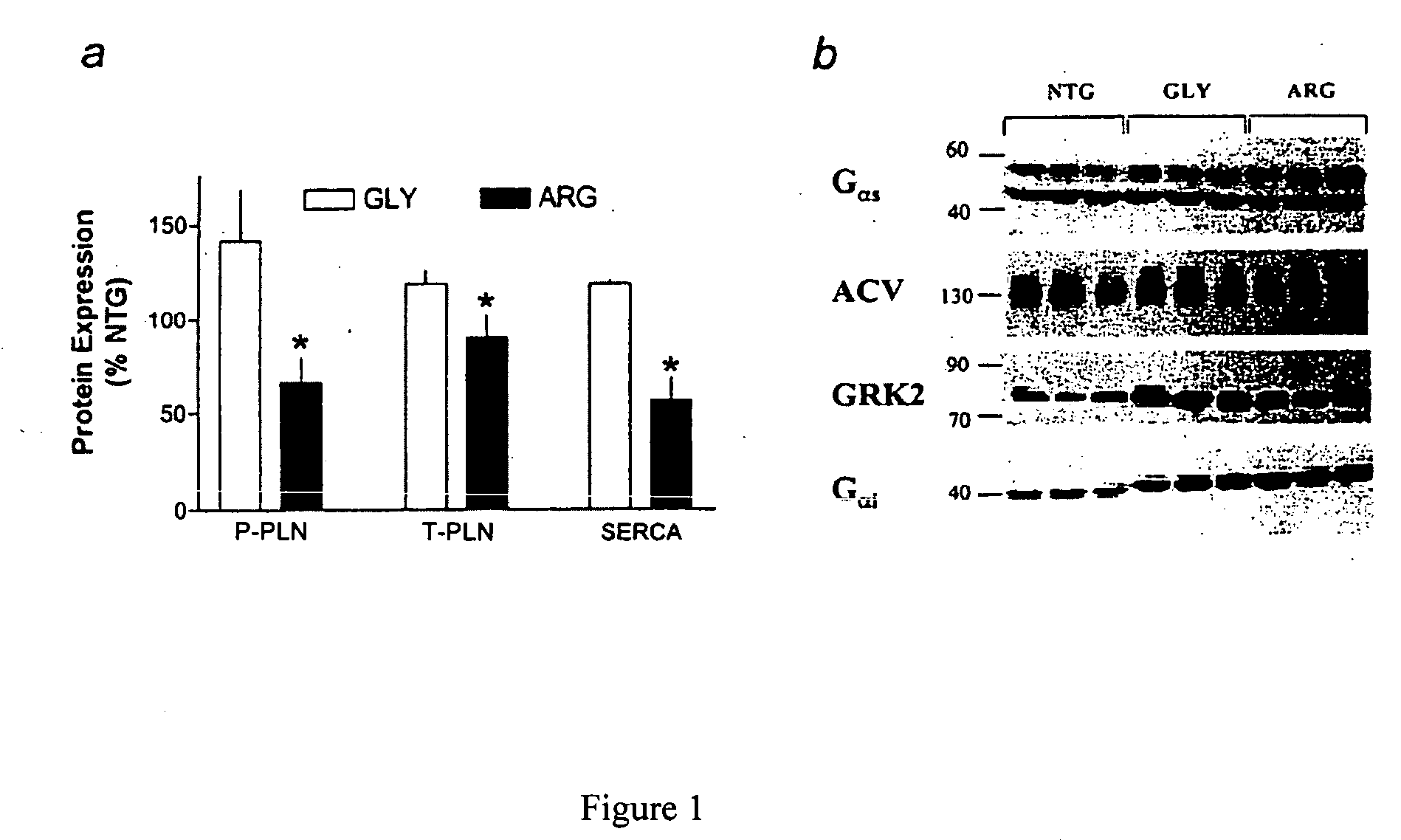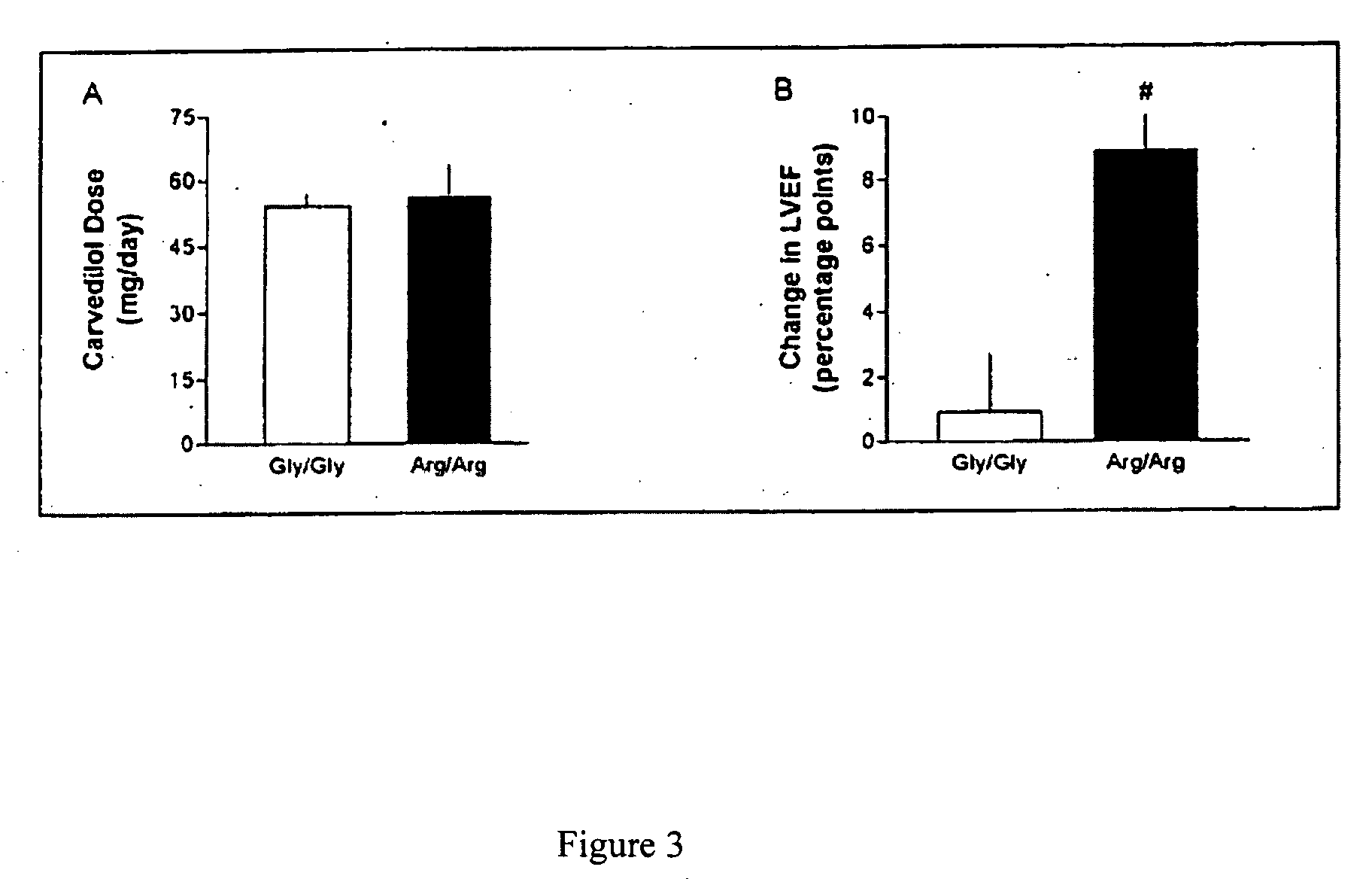Methods for diagnosis, prediction and treatment of heart failure and other cardiac conditions based on beta1-adrenergic receptor polymorphism
a beta1-adrenergic receptor and polymorphism technology, applied in the field of cardiovascular diseases, can solve the problems of high degree of variability in the treatment response of these agents
- Summary
- Abstract
- Description
- Claims
- Application Information
AI Technical Summary
Benefits of technology
Problems solved by technology
Method used
Image
Examples
example 1
Transgenic Mouse Model of β1AR Polymorphisms and Effect on Cardiac Function
[0107] Using the α-myosin heavy chain promoter, transgenic mice with targeted ventricular expression of the human β1AR (Arg389 or Gly389 forms) were utilized to ascertain allele-specific cardiac function over time. Echocardiography was utilized to ascertain cardiac function in the intact mouse. At 3-months of age β1-Arg389 mice and β1-Gly389 mice had equivalent levels of cardiac function, as defined by ventricular fractional shortening: 43±2% vs 42±2% respectively. By 9-months of age, the β1-Arg389 mice displayed dilated ventricles and a markedly decreased fractional shortening (26±2%) as compared to 9-month old β 1-Gly389 mice (42±4%, P=0.02). In addition, 9-month old β1-Arg389 hearts had myocyte loss and replacement fibrosis as determined by light microscopy, while β1-Gly389 hearts were normal.
example 2
Response to β-Blockade in Transgenic Mice
[0108] Transgenic mice with targeted expression of β1-Gly389 or β1-Arg389 to the heart exhibit multiple alterations over time (observed as early as 6-months of age) in the expression of certain cardiac signaling and Ca++ handling proteins. Expression levels of the two receptors were equivalent. 3-month-old mice of both genotypes, as well as nontransgenic mice, were treated with propranolol (0.5 mg / ml) in their drinking water, or water without propranolol (control) continuously for 6 months. Hearts were then removed and ventricular protein extracts prepared. These were subjected to Western blotting to ascertain expression of the proteins Gαs, Gαi2, G-protein coupled receptor kinase-2 (GRK2), adenylyl cyclase type 5 (AC5), total phospholamban (T-PLN), phosphorylated phospholamban (P-PLN) and sarcoplasmic endoplasmic reticulum calcium ATPase-2A (SERCA) using methods described in Perez et al. Nature Med 9: 1300-1305 (2003). Treatment effect was...
example 3
Carvedilol Response by Genotype in Human Heart Failure.
[0110] The study was approved by the University of Cincinnati Institutional Review Board and the patients gave informed consent. Since the transgenic mice exhibited allele-specific response, the protective effects of β-blockade against chronic catecholamine stimulation of cardiac β1-AR in human heart failure likely occurs in patients expressing the Arg389 variant. Thus, it is expected that a greater therapeutic response from Arg389 patients resulting in improvement in left-ventricular function (LVEF). 224 patients (ages 40-65) with ischemic or dilated cardiomyopathy and LVEF6 months on a stable dose. The change in LVEF was reported as the difference between values before and after drug treatment. Patients were genotyped at the β1-AR 389 locus, and the distribution of the patient genotypes (16 Gly389 homozygotes, 95 gly389 / Arg389 heterozygoes and 144 Arg389 homozygotes) was in Hardy-Weinberg equilibrium. The ventricular functio...
PUM
 Login to View More
Login to View More Abstract
Description
Claims
Application Information
 Login to View More
Login to View More - R&D
- Intellectual Property
- Life Sciences
- Materials
- Tech Scout
- Unparalleled Data Quality
- Higher Quality Content
- 60% Fewer Hallucinations
Browse by: Latest US Patents, China's latest patents, Technical Efficacy Thesaurus, Application Domain, Technology Topic, Popular Technical Reports.
© 2025 PatSnap. All rights reserved.Legal|Privacy policy|Modern Slavery Act Transparency Statement|Sitemap|About US| Contact US: help@patsnap.com



